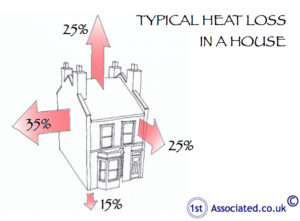How do Buildings Lose and Gain Heat?
Over the years of carrying out Surveys we have seen all sorts of properties and we have also noticed that people have become more interested in the thermal efficiency of their property. 1stAssociated are Independent Surveyors who carry out Building Surveys sometimes known as Structural Surveys and as part of our surveys we consider the thermal efficiency of the property and use a thermal imaging camera to identify problem areas.

Overview
There are three means by which heat transfers in and out of buildings:
1. Conduction
Heat transfers through the fabric of the building by means of each atom transferring energy to adjacent atoms in a solid. The efficiency with which heat transfers through a structure varies according to what the component is made of - with each material having its own characteristic coefficient of thermal conductivity. Generally denser materials transfer more heat than less dense, and the best insulating materials have the lowest density and encapsulate a lot of still air – which is an excellent insulator.
In a double or triple glazed window, conduction is kept low by having sealed chambers filled with air or in some cases helium which has a lower thermal conductivity. Heat does not easily flow across the air in such a chamber.

2. Convection
Convection is a process which occurs in gases and liquids, and occurs because of the fact that they expand as they warm. When a molecule of gas or liquid warms and becomes lighter, it floats up above denser portions of the gas or liquid. In a house, convection losses are largely due to air warming, and rising out of openings like windows, doors, chimneys, vents, and small cracks in various elements of the structure. Convection also causes air to circulate around a room and can result in a draft when a room with cold walls is being heated. Air rises at the source of heat, then drops down adjacent to the cold walls.
On the outside of the building, convection can also play a part in transferring heat. e.g. on a cold day, heat losses will tend to be significantly higher when it is windy than when it is not for two reasons. Firstly, a greater volume of air transfers through the house as the wind pushes or pulls air through cracks, vents, chimneys etc. and secondly airflow across the outside surfaces of the building increases interaction between air and structure carrying away heat from the building's external surfaces by wind driven convection (Wind is a natural product of atmospheric convection).
To reduce convection losses, it is necessary to reduce air transfer between the inside and outside of the building, or to have this air exchange take place through a heat exchanger using mechanical heat recovery ventilation (MHRV). There is a balance to be struck between on the one hand curbing heat loss by making a building airtight, and on the other ensuring there is enough ventilation to remove excess water vapour and to prevent the build-up of pollutants. Too little ventilation, and the building tends to become damp, too much, and the building is hard to heat. MHRV allows for an adequate flow of air into and out of a building whilst capturing most of the heat in the exhaust air and putting it back into the building in the fresh ventilation air.
In a window, the sealed chambers between panes of glass are too close together to allow for very much convection, so preventing the low thermal conductivity of the air from being bypassed by air movement in the chamber.
3. Radiation
We all know how a room can warm up – sometimes too much when the sun shines in through windows. This is caused by incoming radiation in the forms of visible and infrared light. A similar process occurs going through the windows in the opposite direction only this time, there is only a little visible light and a far higher proportion of infrared.
In any modern window, one or more glass panes will be coated with a low emissivity coating which is another way of describing the fact that the glass is coated with a thin layer of material largely opaque to infrared light.
Note: - Conduction, convection and radiation all take place in both directions, into and out of the building affecting the degree of heating and or cooling required to keep the building comfortable. The temperature in a building depends on the balance of heat gains and losses from the building including factors such as the sun shining through windows, and energy used within the home.
One further factor affecting the temperature of a building is the balance between evaporation and condensation. You will have observed how if you have a glass of ice cubes in a warm room, the ice will gradually melt during which, the water remains at or very neat 0 Centigrade. Only when all the ice has melted will the water begin to warm. This occurs because it takes a considerable amount of energy to drive the phase change between ice and water. In the same way, it takes a lot of energy to turn water from liquid to vapour.
In most buildings, activities take place which cause water vapour to be created – cooking, boiling kettles, sweating, and evaporation from baths, toilets, etc. This process is driven by heat, and its reverse condensation releases heat whilst chilling the surface on which water condenses. Air at a given temperature can hold only a certain amount of water in vapour form, and any excess moisture will condense out either on surfaces or as mist, clouds or rain. Above freezing point, the amount of water vapour air can hold without condensation rises rapidly with temperature from just 4.89 grams per m3 at freezing to 17.3 grams at 20 centigrade, and 30.4 grams at 30 centigrade. It is very undesirable to have water vapour condensing on surfaces inside a building as the moist conditions so created facilitate growth of fungi such as mould, dry rot, and wet rot as well as other problems to the structure, so ideally moisture levels will be kept down, and walls and other surfaces will be sufficiently well insulated that they will not be at a much different temperature to the air in the building.
Please note that where a building element such as a wall is made up of different layers with cavities between them, it is possible for condensation to form inside the cavity, and hence important to maintain some degree of ventilation through the cavity.
Independent Surveyors
If you truly do want an independent expert opinion from a surveyor with regard to building surveys, structural surveys, structural reports, engineers reports, specific defects report, dilapidations or any other property matters:
Free Phone 0800 298 5424 for a friendly chat with one of our surveyors
Other Articles to Read
Click on the links below for further information:
New House Heating System
Air Conditioning System
Condensation, Damp and Black Mould
Heat Pumps
Ground / Water Source Heat Pump
Commercial property surveyors
If you have a commercial property, be it leasehold or freehold, then you may wish to look at our Dilapidations Website at www.DilapsHelp.com and for Disputes go to our Disputes Help site www.DisputesHelp.com .
1stAssociated articles
We hope you found the article of use and if you have any experiences that you feel should be added to this article that would benefit others, or you feel that some of the information that we have put is wrong, then please do not hesitate to contact us (we are only human). For more information contact us on Free Phone 0800 298 5424.
The contents of the website are for general information only and is not intended to be relied upon for specific or general decisions. Appropriate independent professional advice should be paid for before making such a decision.
All rights are reserved, the contents of the website are not to be reproduced or transmitted in any form in whole or part without the express written permission of www.1stAssociated.co.uk.
